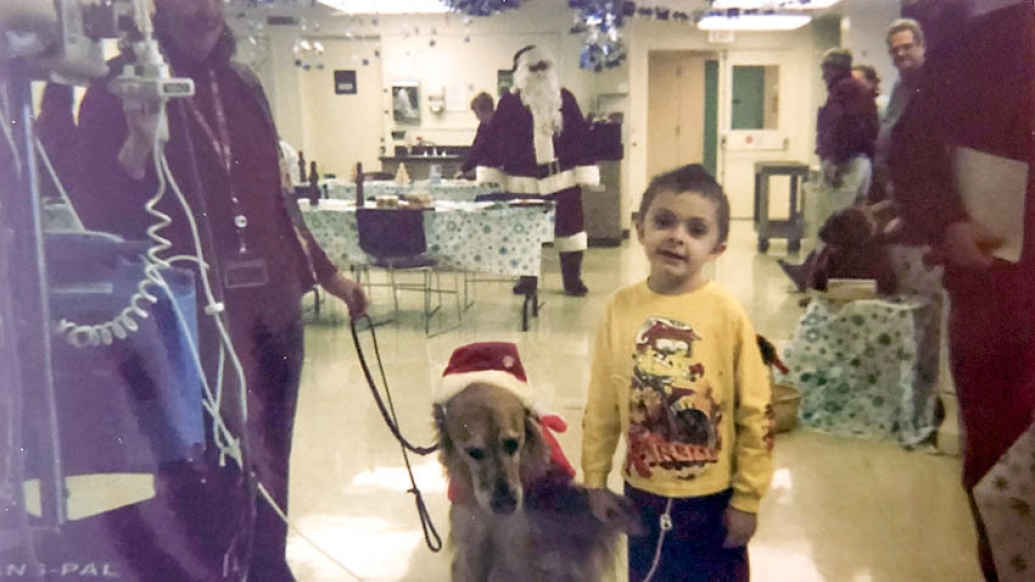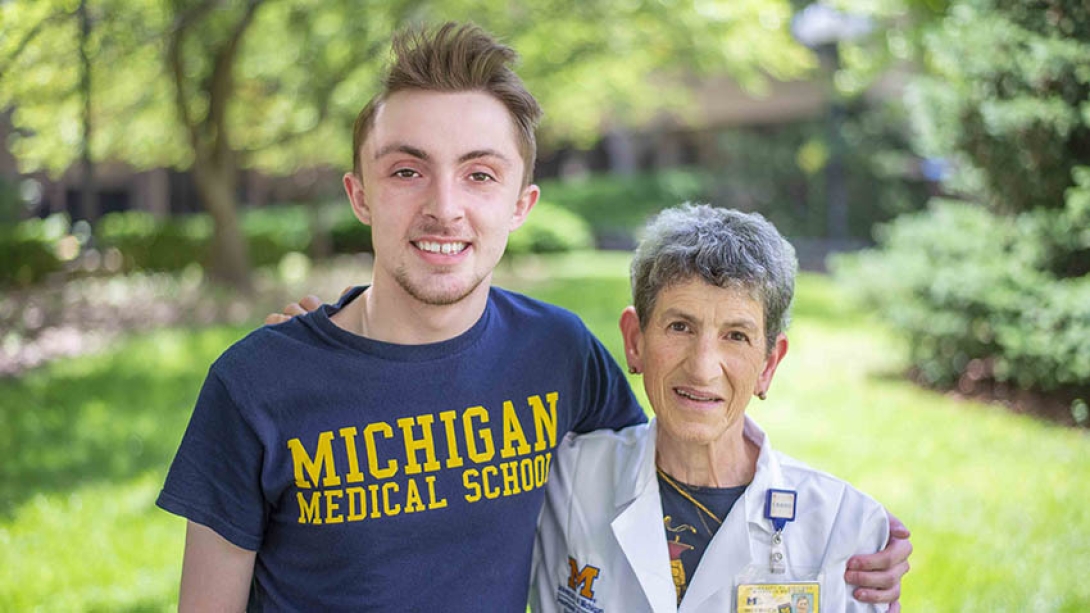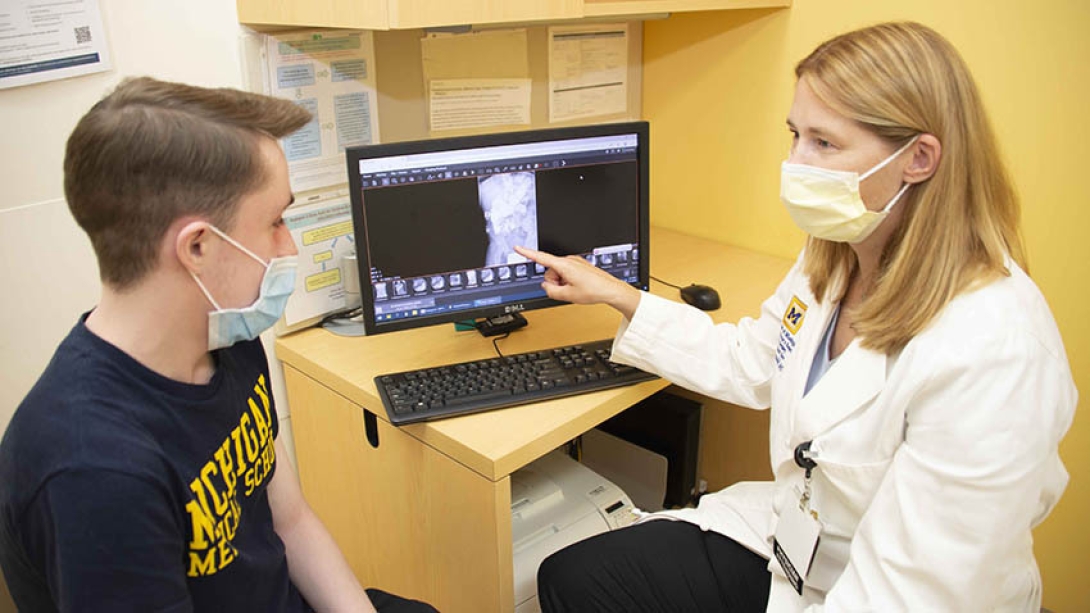A life-threatening diagnosis at age 5 and compassionate care throughout childhood inspired Blake Hardin to pursue medicine.
8:18 AM
Author |

While walking outside in the University of Michigan Hospital courtyard on a scorching summer afternoon, Blake Hardin described feeling deja vu.
He pointed to the small, blue, and pink playhouse underneath the shade of trees and recalled the last time he was here: "I used to come outside here with my mom, and I remember wanting to play in that house. It's been so long since I've been out here," Hardin said.
When life changed
Seventeen years ago, Hardin was an active, busy and carefree five-year-old. He can remember when he graduated from kindergarten and life felt so simple. He also remembers when that all changed, and life became much more complicated.
It started when a flu bug circled through his house, starting with his parents getting sick, and soon hitting him. "I remember feeling tired and lethargic, similar to what my family was going through."
There were usual signs of illness like feeling tired and sleeping a lot.
But there was one symptom that his family wasn't experiencing — jaundice, a condition that brings a yellowish tint to the skin and often signals concern for liver damage. Hardin's skin began turning yellow, and eventually his eyes and even the bottoms of his feet appeared the distinct color.
Something was wrong, and it wasn't the flu. His parents rushed him to his primary care physician.
During his visit, Hardin's blood pressure was flagged as abnormal, and it was clear that he needed more specialized care. The physician called 911 and sent Hardin and his parents to a nearby hospital. Upon arrival, the children's team realized he was in a critical state that required specialty care.
Congenital discovery and emergency care
Because of his critical condition, the Michigan Medicine Survival Flight team was sent to pick up Hardin and take him to University of Michigan Health C.S. Mott Children's Hospital, which has the largest pediatric intestinal rehabilitation program in the state.
Once there, Hardin underwent emergency surgery where doctors discovered that he had intestinal malrotation with volvulus—a congenital birth abnormality—where the intestines can become twisted which can block or restrict blood flow.
"Malrotation occurs in about 1 in 200 people, and most people never know they have it," said Meghan Arnold M.D., clinical associate professor of pediatric surgery, and one of Hardin's current care physicians at Mott.
Like Podcasts? Add the Michigan Medicine News Break on Spotify, Apple Podcasts or anywhere you listen to podcasts
"The reason it's important is if you have it, you are at risk for most of your small intestine to twist. If that happens, it can cut off the blood supply to the small intestine."
Hardin's intestines were in a knot, and the twisting of the small intestine resulted in a volvulus with a complete blockage. Because of the lack of blood supply while the intestines were twisted, most of his small bowel was dead and had to be removed, which resulted in short bowel syndrome. With this shortened intestinal length, Hardin was going to require intravenous nutrition, also known as TPN, to grow and develop normally.
For Hardin to heal, he was put into a medically induced coma until he stabilized, followed by a months-long hospitalization at Mott while he continued his recovery.
During that time, Hardin found himself surrounded by the compassionate staff of the Mott Children's Intestinal Rehabilitation Program (ChIRP). This team specializes in the care of children who require long term TPN and continues to be the largest intestinal rehabilitation program in Michigan.
"I loved seeing Dr. Brown (Pamela Brown, M.D., retired Pediatric Gastroenterologist and Clinical Associate Professor of Pediatrics and Communicable Diseases Emeritus, and co-founder of ChIRP), and my family fell in love with the care team because they treated my family like they were their own family," said Hardin.
A new way of living
After this initial hospitalization, Hardin had to learn to walk again, and eventually he recovered fully. Hardin received another surgery in 2008 to lengthen his intestines in an attempt to allow him to not have to rely on the IV nutrition. But life would still be different for Hardin, unlike what many children would experience.
Due to short bowel syndrome, Hardin and his family had to be diligent about what he ate and took any hint of a cold or flu with serious caution. Hardin also required supplemental feeding and nutrition that was administered through a catheter as well as a feeding tube—all which he carried in a small backpack.
After being home-schooled for one year due to his recovery and surgeries, Hardin returned to public school to attend second grade. He remembered how difficult it was for him to interact with kids in school, partly because he was away from social interaction with his peers, and partly because of the physical signs of his condition.
"Kids seeing someone who is different, having this backpack with my supplemental feeding…it was very challenging," he said. "I was bullied a lot and judged for my condition, and it really hurt."
Perseverance and forever Go Blue
As Hardin grew up, he found friends and support systems that helped him throughout his journey. By high school, he began to connect his love of sciences with his care team at Mott.
"I remember being admitted in the hospital and being seen in the ChIRP clinic. For any child it is an awful and lonely experience," he said. "But I remember how the health care team at Mott provided an example of the type of compassionate and patient centered care that I wanted to emulate," Hardin recalled.
Very often, kids have these life altering surgeries or diagnoses, and their parents start to think about what their kids can't do…Our goal in the ChiRP clinic is to maximize what they can do.Meghan Arnold, M.D.
Because of his experience as a young patient, combined with his love of science and his admiration for the Mott care team, Hardin decided to go to medical school to become a physician.
After graduating from the University of Michigan-Dearborn in 2021, Hardin had a competitive medical school application that allowed him to apply to the top medical schools in the country.
"University of Michigan was always a top choice, not just because of the medical school curriculum, or because it's close to home, but because of my experience with the ChIRP program within Mott," he said.
Hardin's full circle moment came true when he was officially accepted into the U-M Medical School, where he'll attend his white coat ceremony in July.
After his acceptance, there was one person he was eager to contact: Pamela Brown, who helped save his life as a child.
He remains in contact with her, and she couldn't be prouder to see where he is now.
"Blake is an inspiration to me," she said

A bright future
Today, Hardin is keeping an open mind about his field of study as a future physician. He has empathy for children with chronic illnesses, and he's interested in pediatrics, internal medicine and gastroenterology.
But most importantly, he wants to be a physician that provides the same type of compassion that he received from Mott.
Now 22 years old, Hardin is preparing for the demanding life of a medical student. While he attends school, the Mott ChiRP team will remain close by (literally and figuratively). His current care team consists of at least five medical professionals, all who are rooting for Hardin to succeed

"What's so special about our program is that we have a core group of people who are dedicated to short bowel and intestinal anomalies, and our goal is to optimize what our patients are capable of," said Arnold.
"Very often, kids have these life altering surgeries or diagnoses, and parents think of what their kids can't do, especially after diagnoses. Our goal in the clinic is to maximize what they can do. Here's a kid (Hardin), who's had higher than average medical needs, and now he's going to medical school."
Having a patient go on to medical school is a first for the Mott ChiRP clinic, and his doctors say Hardin is living proof of what is possible for young children and adults who live with short bowel syndrome.
"Life may be different for him, but that doesn't mean that it's any less than someone without these challenges," Arnold.
And Hardin plans to show his patients that, no matter what part of their health experience they're going through, they're never alone. "I'm going to be there for them, treat them with respect, and comfort and guide them through the scary process of receiving medical treatment," Hardin said.
Live your healthiest life: Get tips from top experts weekly. Subscribe to the Michigan Health blog newsletter
Headlines from the frontlines: The power of scientific discovery harnessed and delivered to your inbox every week. Subscribe to the Michigan Health Lab blog newsletter

Explore a variety of health care news & stories by visiting the Health Lab home page for more articles.

Department of Communication at Michigan Medicine
Want top health & research news weekly? Sign up for Health Lab’s newsletters today!





